Haiyong Chen
Senior Member, IEEE
Photovoltaic Defect Image Generator with Boundary Alignment Smoothing Constraint for Domain Shift Mitigation
May 09, 2025Abstract:Accurate defect detection of photovoltaic (PV) cells is critical for ensuring quality and efficiency in intelligent PV manufacturing systems. However, the scarcity of rich defect data poses substantial challenges for effective model training. While existing methods have explored generative models to augment datasets, they often suffer from instability, limited diversity, and domain shifts. To address these issues, we propose PDIG, a Photovoltaic Defect Image Generator based on Stable Diffusion (SD). PDIG leverages the strong priors learned from large-scale datasets to enhance generation quality under limited data. Specifically, we introduce a Semantic Concept Embedding (SCE) module that incorporates text-conditioned priors to capture the relational concepts between defect types and their appearances. To further enrich the domain distribution, we design a Lightweight Industrial Style Adaptor (LISA), which injects industrial defect characteristics into the SD model through cross-disentangled attention. At inference, we propose a Text-Image Dual-Space Constraints (TIDSC) module, enforcing the quality of generated images via positional consistency and spatial smoothing alignment. Extensive experiments demonstrate that PDIG achieves superior realism and diversity compared to state-of-the-art methods. Specifically, our approach improves Frechet Inception Distance (FID) by 19.16 points over the second-best method and significantly enhances the performance of downstream defect detection tasks.
GDDS: A Single Domain Generalized Defect Detection Frame of Open World Scenario using Gather and Distribute Domain-shift Suppression Network
Jul 18, 2024



Abstract:Efficient and intelligent surface defect detection of photovoltaic modules is crucial for improving the quality of photovoltaic modules and ensuring the reliable operation of large-scale infrastructure. However, the scenario characteristics of data distribution deviation make the construction of defect detection models for open world scenarios such as photovoltaic manufacturing and power plant inspections a challenge. Therefore, we propose the Gather and Distribute Domain shift Suppression Network (GDDS). It adopts a single domain generalized method that is completely independent of the test samples to address the problem of distribution shift. Using a one-stage network as the baseline network breaks through the limitations of traditional domain generalization methods that typically use two-stage networks. It not only balances detection accuracy and speed but also simplifies the model deployment and application process. The GDDS includes two modules: DeepSpine Module and Gather and Distribute Module. Specifically, the DeepSpine Module applies a wider range of contextual information and suppresses background style shift by acquiring and concatenating multi-scale features. The Gather and Distribute Module collects and distributes global information to achieve cross layer interactive learning of multi-scale channel features and suppress defect instance shift. Furthermore, the GDDS utilizes normalized Wasserstein distance for similarity measurement, reducing measurement errors caused by bounding box position deviations. We conducted a comprehensive evaluation of GDDS on the EL endogenous shift dataset and Photovoltaic inspection infrared image dataset. The experimental results showed that GDDS can adapt to defect detection in open world scenarios faster and better than other state-of-the-art methods.
SIGAN: A Novel Image Generation Method for Solar Cell Defect Segmentation and Augmentation
Apr 11, 2021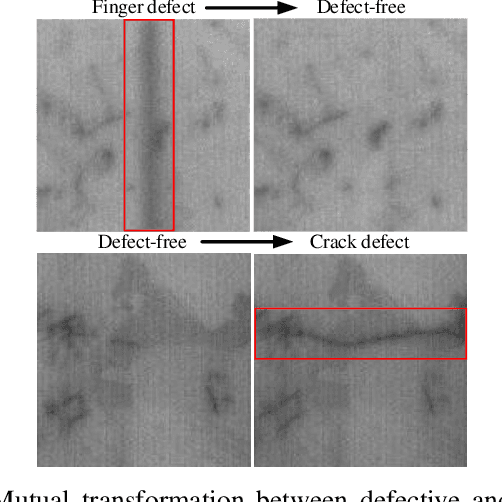
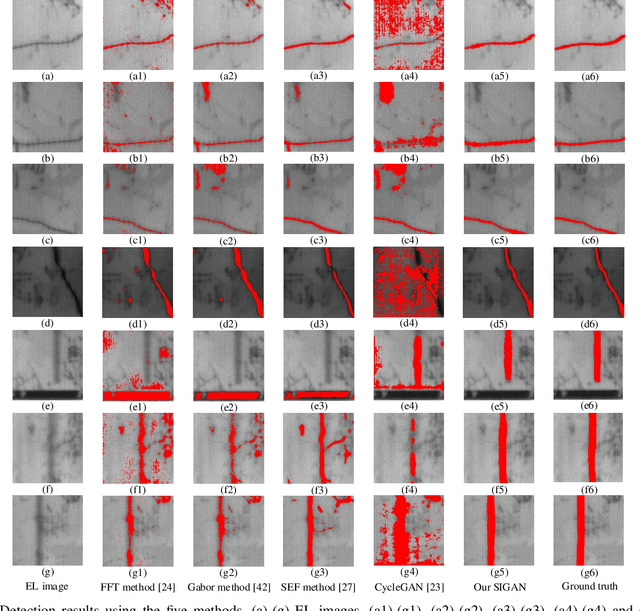
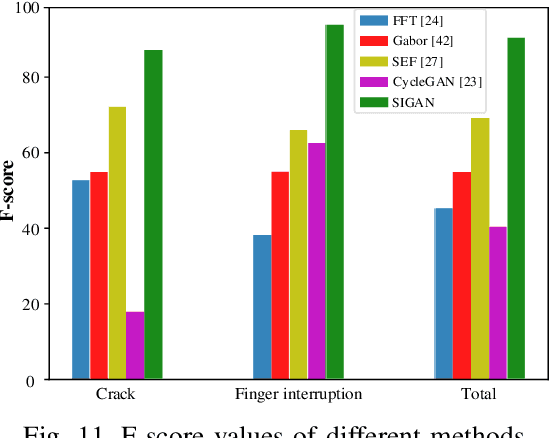
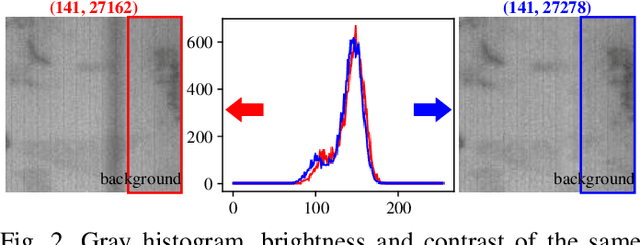
Abstract:Solar cell electroluminescence (EL) defect segmentation is an interesting and challenging topic. Many methods have been proposed for EL defect detection, but these methods are still unsatisfactory due to the diversity of the defect and background. In this paper, we provide a new idea of using generative adversarial network (GAN) for defect segmentation. Firstly, the GAN-based method removes the defect region in the input defective image to get a defect-free image, while keeping the background almost unchanged. Then, the subtracted image is obtained by making difference between the defective input image with the generated defect-free image. Finally, the defect region can be segmented through thresholding the subtracted image. To keep the background unchanged before and after image generation, we propose a novel strong identity GAN (SIGAN), which adopts a novel strong identity loss to constraint the background consistency. The SIGAN can be used not only for defect segmentation, but also small-samples defective dataset augmentation. Moreover, we release a new solar cell EL image dataset named as EL-2019, which includes three types of images: crack, finger interruption and defect-free. Experiments on EL-2019 dataset show that the proposed method achieves 90.34% F-score, which outperforms many state-of-the-art methods in terms of solar cell defects segmentation results.
BAF-Detector: An Efficient CNN-Based Detector for Photovoltaic Solar Cell Defect Detection
Dec 19, 2020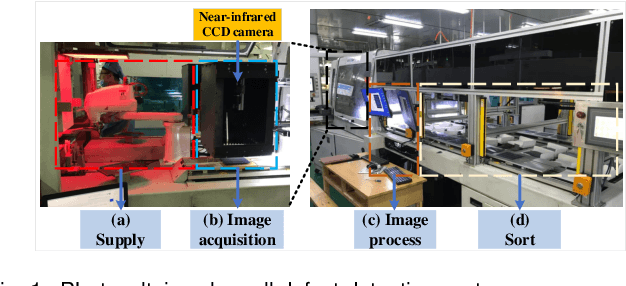
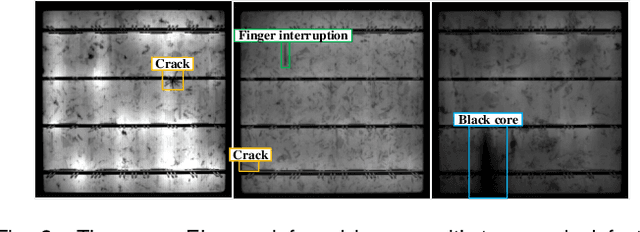
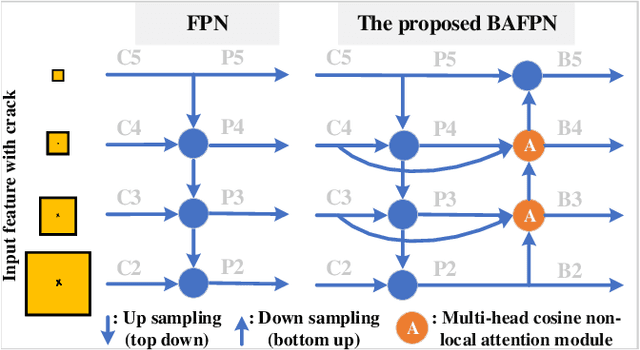
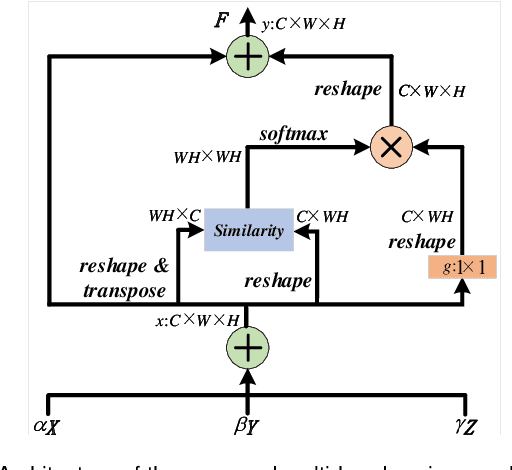
Abstract:The multi-scale defect detection for solar cell electroluminescence (EL) images is a challenging task, due to the feature vanishing as network deepens. To address this problem, a novel Bidirectional Attention Feature Pyramid Network (BAFPN) is designed by combining the novel multi-head cosine non-local attention module with top-down and bottom-up feature pyramid networks through bidirectional cross-scale connections, which can make all layers of the pyramid share similar semantic features. In multi-head cosine non-local attention module, cosine function is applied to compute the similarity matrix of the input features. Furthermore, a novel object detector is proposed, called BAF-Detector, which embeds BAFPN into Region Proposal Network (RPN) in Faster RCNN+FPN to improve the detection effect of multi-scale defects in solar cell EL images. Finally, some experimental results on a large-scale EL dataset including 3629 images, 2129 of which are defective, show that the proposed method performs much better than other methods in terms of multi-scale defects classification and detection results in raw solar cell EL images.
Solar Cell Surface Defect Inspection Based on Multispectral Convolutional Neural Network
Dec 15, 2018



Abstract:Similar and indeterminate defect detection of solar cell surface with heterogeneous texture and complex background is a challenge of solar cell manufacturing. The traditional manufacturing process relies on human eye detection which requires a large number of workers without a stable and good detection effect. In order to solve the problem, a visual defect detection method based on multi-spectral deep convolutional neural network (CNN) is designed in this paper. Firstly, a selected CNN model is established. By adjusting the depth and width of the model, the influence of model depth and kernel size on the recognition result is evaluated. The optimal CNN model structure is selected. Secondly, the light spectrum features of solar cell color image are analyzed. It is found that a variety of defects exhibited different distinguishable characteristics in different spectral bands. Thus, a multi-spectral CNN model is constructed to enhance the discrimination ability of the model to distinguish between complex texture background features and defect features. Finally, some experimental results and K-fold cross validation show that the multi-spectral deep CNN model can effectively detect the solar cell surface defects with higher accuracy and greater adaptability. The accuracy of defect recognition reaches 94.30%. Applying such an algorithm can increase the efficiency of solar cell manufacturing and make the manufacturing process smarter.
 Add to Chrome
Add to Chrome Add to Firefox
Add to Firefox Add to Edge
Add to Edge